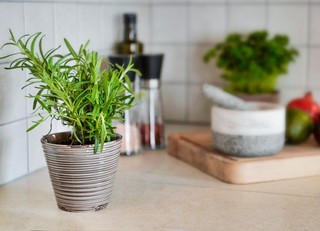How to grow Rosemary indoors

Parsley, sage, rosemary, and…well, you know where I’m going with that. Luckily for me, it’s been stuck in my head since I sat down to work on this article. Now that you’ve got that little ditty in your head now too, let’s take some time to talk about everything you should know to grow rosemary indoors.
Supplies
All you will need to grow rosemary indoors is the basics: growing media, containers, and plants.
Growing media: Rosemary likes its roots to be slightly dry so you need a growing media with really good drainage. Some people plant it in a growing mix formulated for succulents. Or you could mix additional sand, perlite, or vermiculite into a commercial potting soil you purchase from the gardening center. Avoid using garden soil in your containers; it is really heavy and compacts down, closing the pore space that can hold air and water in the root zone.
Containers: Containers should be the same depth as the height of the plant. If the plant is getting taller than the pot is deep, it’s time to repot into a larger pot and do some root pruning to keep the plant from getting any taller. Make sure they have drainage holes. A terra cotta pot works best; the porous sidewalls let water move through them, helping to dry out the growing media quicker.
Plants: Plant material can either be outdoor plants that you’re bringing inside for the winter or new plants that you’re intending to grow. It will be explained more in the coming sections, but it’s best to propagate new plants from cuttings instead of purchasing seed to start new plants.

How to propagate stem cuttings
Rosemary is best propagated from stem cuttings versus trying to start new plants from seeds. Seeds have very low germination rates and seedlings struggle to establish, making it easier and less expensive to take softwood stem cuttings from existing specimens and propagate new plants.
Starting new plants from cuttings also results in new plants that are genetically identical, or clones, to the “mother” plant. This limits variability that comes with starting new plants from seeds.
- Take 5 to 6-inch stem cuttings just below a node. You want to choose fresh growth from healthy stems; these are the green, flexible ones on your rosemary plants. Avoid the older stems that are brown and woody. Cut more than you ultimately want for new plants, in case some perish instead of rooting.
- Using your fingers, strip all of the needles from the bottom 2 inches of the stem. These junctions where the needles attached to the stem (known as nodes) are the spots where new roots will form.
- Place the cut end of the stem in a glass or jar of water in a warm location away from direct sunlight. Allow the cutting to grow until new roots form and reach a couple of inches long. This could take upwards of 8 weeks, so be patient. The cuttings that do not survive will be brown and shed needles.
- Once the new roots have reached the desired length you can put them into containers. Following the same method as transplanting new plants, or repotting plants, fill your container(s) with pre-moistened growing media and carefully plant newly rooted cuttings in the substrate.

Indoor growing conditions
The environmental conditions (temperature, lighting, and humidity) in most homes are well suited for herbs, rosemary included. Most indoor plants prefer warm, sunny locations and thrive when given optimum conditions. This means providing the appropriate sunlight exposure, ambient temperature, and relative humidity to promote healthy plant growth and the best tasting foliage.
Temperature
Rosemary plants like ambient temperatures on the cooler side, optimally between 60 and 65℉ during the day but they will survive indoors when temps are between 55 and 80℉. It’s best if nighttime temperatures drop slightly too, to mimic the change naturally experienced outdoors after sunset.
Lighting
Rosemary needs a full sun (south-facing window) location that receives a minimum of 6 to 8 hours of direct light a day or supplementation with a grow light. If your plants are struggling with lack of sunlight they will begin to look wiry or leggy. Adequate light is necessary for photosynthesis – the process of converting carbon dioxide and water into sugar the plants can use for food.
Relative humidity
Due to their Mediterranean origin, rosemary likes higher relative humidity since they were used to really humid air because of the sea. To increase the relative humidity directly around your plants, you can keep them in a pebble tray to maintain high humidity and periodically mist the plant as well.
Care
- Allow the soil to dry out between waterings, keeping it on the drier side overall. Let the top 1-inch of growing media dry out before watering thoroughly again. In the winter when growth slows make sure to cut back on the watering schedule. Rosemary is susceptible to root rot, an often fatal fungal root disease, due to overwatering.
- Rotate plants every few days to prevent them from bending towards the light even when grown on a windowsill in bright light. This phenomenon is known as phototropism – plant growth hormones move to the shaded side of the plant, causing cells there to elongate, “pushing” the plant towards the sunlight (Whippo, & Hangarter, 2006).
- Maintain good air circulation around and through the plants. Even though they like higher humidity they can have problems with fungal diseases such as powdery mildewif the airflow isn’t adequate.
- Feed container-grown rosemary plants with a water-soluble fertilizer in early April. This gives plants a boost as they go into their active growing season. Like other herbs, rosemary doesn’t require much fertilization other than this. If growth appears to be stunted or foliage is turning a pale green you may add a low dose of fertilizer to see if plant growth improves.
- Treat insect pests quickly to minimize damage. Indoor rosemary plants are more prone to insect infestations than plants grown outdoors. Watch for aphids or spider mites, treating plants with neem oil or insecticidal soap if insects are present.
- Prune plants regularly to promote bushiness. Remove the tops of the stems to enhance the growth of lateral branches, making plants grow outwards instead of upwards.
- To keep plants at a designated height, you’ll need to root prune them periodically. This is best done when repotting them. When you attempt root pruning, prune 2 inches of root matter off the bottom and sides of the root ball using sterilized, sharp cutting tools when you have it out of the container. Then re-pot it with new soil.
- Harvest material frequently to keep plants healthy and strong.Give newly propagated plants some time to grow and establish good root systems before harvesting. If possible let new growth on plants reach at least 6-inches in height before removing any material. And then take no more than ⅓ of the plant at any time.

Rosemary Info
Native to the Mediterranean, rosemary (Rosmarinus officinalis) is a perennial herb found in many outdoor herb gardens (mine included). It can grow outside, year-round, in USDA Hardiness Zones 8 and warmer. When allowed to grow outside all year long in the garden plants can grow 4 feet tall and spread up to about 4 feet wide depending on the variety.
In areas with winter temperatures dip below 30℉, you’ll need to bring your rosemary indoors for the winter, or you’ll find a completely dead plant come spring. On the upside, they make great houseplants, looking like a mini Christmas tree with a fantastic aroma.
Uses
Fresh rosemary has a wide variety of uses, ranging from flavoring recipes to homeopathic benefits from rosemary essential oil. This range of applications is partly why rosemary is so popular amongst gardeners.
Culinary
Most people think of rosemary’s culinary uses before anything else. It is commonly used to season a variety of dishes including soups, stews, and casseroles; and pairs extremely well with a variety of meats. Use it to flavor chicken and other poultry, game meats, steaks, lamb, pork, and fish.
It is also commonly used to make rosemary butter, or infused in olive oil or salt to flavor dishes.
Homeopathic
Rosemary also has many homeopathic uses, dating back to ancient times, due to a high level of antioxidants and anti-inflammatory properties found in the plant. It was traditionally used to ease muscle pain, improve memory, boost the immune and circulatory system, and promote hair growth.
Now it is used for numerous applications in aromatherapy:
- As an insect repellent because of its strong-smelling essential oils.
- To improve mental state/status. Rosemary oil may increase feelings of content, decrease cortisol levels in the body, and improve alertness and cognitive function.
It may also improve skin conditions such as dermatitis, eczema, and rosacea and is useful in hair health to improve dandruff and dry scalp. In 1999 a review article concluded that rosemary supports liver health by increasing bile production and protecting the liver from damage.[1]
Conclusion
Growing rosemary indoors is fairly straightforward, and sometimes a necessity depending on your growing zone, if you give it enough sunlight, keep the soil somewhat dry, and prune/harvest material often.

The enthusiast's guide to herbs
We’re proud to present our new e-book, The Enthusiast’s Guide to Herbs! Learn everything you need to know about growing and caring for herbs indoors, including in-depth info cards for the 35 most commonly grown herbs.
Click the link below to find out more!
Whippo, C. W., & Hangarter, R. P. (2006). Phototropism: Bending towards Enlightenment. The Plant Cell, 18(5), 1110-1119. doi: 10.1105/tpc.105.039669 ↩︎
